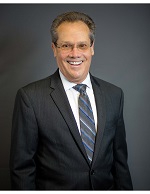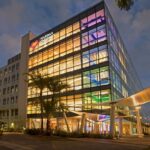 “As we’ve discussed with the doctors we’re selling it to,” said Jeremy Larkin, “imagine the day when you can drive into a covered parking garage, park your car, go up to your office and when you need to run to the hospital, take an elevator down and walk across the street. It’s a dream come true.”
“As we’ve discussed with the doctors we’re selling it to,” said Jeremy Larkin, “imagine the day when you can drive into a covered parking garage, park your car, go up to your office and when you need to run to the hospital, take an elevator down and walk across the street. It’s a dream come true.”
Larkin is president of NAI Miami, a global network of independent commercial real estate firms. He was talking about one of his latest real estate projects, The Agopa a twin tower, state-of-the-art, medical office condominium complex, being developed by his client, Acropolis Realty, L.L.C., which will be located adjacent to Baptist Hospital Kendall Campus.
“And,” he went on to say, “it would be a dream come true if it was a rental situation. Now, imagine the fact that you can buy a unit and be there forever. You never have to worry about your rent increasing. The operating expenses go up but the base rent will never increase. And by the time you’re ready to retire or get rid of the practice, you have the practice to sell and you have the condo to sell after paying down or off its mortgage.”
Larkin talked about the project, and particularly the need for it, in more detail. “(Baptist) is the premier medical facility in the Miami area,” he said. “The campus is extremely large and has a tremendous amount of traffic and congestion. There are two medical buildings on site, and then there are multiple medical buildings around the area. The medical buildings on site are premier buildings, they just have certain limitations.”
As he explained, the outpatient facility is at the bottom of one of the buildings that connects to the parking garage. So to get to his or her office, the doctor first has to fight parking-garage traffic, then go through the outpatient entrance, and finally take the elevator upstairs. For that reason, many of the doctors have moved to off-campus rental facilities that are less congested; however, when they need to go to the hospital, they have to get in their cars and drive there, and once again get caught in that congestion.
“We’ve created an alternative,” Larkin said. “We’re supporting the development of the first being-able-to-walk-to-the-hospital office condominium in South Dade.”
NAI Miami, which was founded 10 years ago by Larkin and his partner, Ed Schmidt, is able to undertake a project of this size because it is part of a global network of commercial real estate firms that band together as one group. Before becoming part of the network, NAI Miami served mostly the Miami and Fort Lauderdale markets, but Larkin said they had clients who were expanding internationally.
To continue to provide those clients with excellent service, Larkin realized his firm had to expand as well. “As a local firm, we did not have the global platform,” he said, “and we went searching for it and looked at all the different alternatives. This was the best. We did not have a problem with relinquishing a little bit of our independence by branding and changing the name of the firm in order to become part of a global platform.
“We look alike, we brand alike, we market alike, we advertise alike,” Larkin continued, “so that we’re able to provide global services to our clientele faster, better, and more efficiently than the national and international firms, because (the network) is entrepreneurially driven from the ground up.” He said the network has 350 offices worldwide in 45 countries.
“As companies become more internationally oriented, there is a growing need for being able to deploy resources to the lowest cost providers, wherever they are globally,” Larkin said. “And with the Internet, it has actually flattened things out so that I can use a vendor in India, another vendor in Vietnam, a third vendor in Europe and a fourth one in Des Moines, and link them and actually be able to accomplish things.”
With regard to The Agora, Larkin said, “When we’re talking with a doctor, he’ll say, ‘Tell me about your competition,’ and I say, ‘There is none.’ This is the Picasso of the medical office. It’s rare, it’s unique, and there is so much inherent value that we should probably charge more than we’re charging. If you want the Rolls Royce, we have it.”
Larkin said the two towers will have about 100,000 square feet. Ground will be broken in the first quarter of 2008, with completion expected in the third quarter of 2009. Yet with just eight weeks of marketing, he said about 30 percent of the building has already been sold. “We haven’t broken ground yet,” he said. “By the time it’s finished, there won’t be any opportunities to buy.”
Post Views: 795
 “As we’ve discussed with the doctors we’re selling it to,” said Jeremy Larkin, “imagine the day when you can drive into a covered parking garage, park your car, go up to your office and when you need to run to the hospital, take an elevator down and walk across the street. It’s a dream come true.”
“As we’ve discussed with the doctors we’re selling it to,” said Jeremy Larkin, “imagine the day when you can drive into a covered parking garage, park your car, go up to your office and when you need to run to the hospital, take an elevator down and walk across the street. It’s a dream come true.” 


























